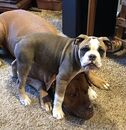- Sep 16, 2010
- 5,939
- 336
- Country
- Canada
- Bulldog(s) Names
- The Stig Racecar Driver and (Sweet Angel) Punkin Brutus
Why you NEED and What you should have in a Pet First Aid Kit | Veterinary Secrets Blog with Dr. Andrew Jones, DVM
Over nearly 20 years of Veterinary Practice, I have seen THOUSANDS of pet Ailments that could have been treated at home- especially if the owners had caught the problem EARLY, and used an EFFECTIVE Home Remedy.
You should ALL have a basic First Aid Kit- so in the interest of helping your pet, and lowering your Veterinary Fees, here are my suggestions:
It is necessary to have a good first aid kit in order to be prepared for emergencies. There should be a first aid kit in your car, at your job site, and in your home. The more complete your first aid kits are the better you can deal with emergencies when they happen. The best time to assemble those kits is now. If you wait until you are in an emergency situation, you will be too late.
If you have animals, then supplies for them should be included in both your car and your home first aid kits.
The primary objectives of first aid are to relieve suffering, to save a life and to prevent further physical or psychological injuries until you can reach or be reached by qualified health care personnel. These goals will help you assemble your first aid kits. Consider all of the possible emergencies that can happen.
First aid kits should be kept in containers that are labeled as such. Small containers that work well for first aid kits are cosmetic boxes, sewing boxes, tackle boxes, tool boxes, etc. If you purchase your supplies first, you will have a better idea what size box you will need.
Keep the box in a single location in your house, car and work place. Everyone should know where it is. If you are the injured party and unconscious or if you are not present at the time of injury, the best first aid kit in the world will not help when no one can find it. It should be stored out of the reach of very young children and pets.
Here are some basic items that all first aid kits should contain:
1. Rectal Thermometer: The newer electronic kind works best. The electronic ones beep when they are finished registering a temperature. They are slightly smaller than the glass kind. They do not break as easily. They can be covered with thin sleeves to halt the spread of germs. They can also be used as oral thermometers. They do have a battery which will need replacing and they are more expensive then the glass ones.
2. Lubricating Jelly: to lubricate thermometer.
3. Gel packs: Can be used for hot and cold compresses.
4. Adhesive tape: to secure bandages – both non-stick tape and water proof tape.
5. Blunt tipped scissors: a must for animal first aid – used for cutting hair away from wounds.
6. Bandage scissors
7. Splints
8. Alcohol swabs: to sterilize instruments or small areas of skin.
9. Antibiotic ointment: for wounds (not for eyes e.g. Polysporin, for non puncture type wounds).
10. Contact lens solution: for rinsing eyes, to clean wounds (water can be substituted).
11. Cotton swabs: i.e. Q-tips.
12. Hibitane: a mild antibacterial soap for cleaning skin, wounds.
13. Sterile cotton or cotton balls
14. Sterile Gauze Pads: the larger 4 inch size is better since it can easily be cut smaller if necessary.
15. Rolls of gauze or cling gauze bandage: 1-2 inch size.
16. Hydrogen Peroxide: 10 ml every 15 minutes to induce vomiting in animals that have ingested a non-caustic poison.
17. Razor Blade: can also be used to shave away hair and abrade the skin following a tick bite.
18. Stockingette: to protect bandage on leg or foot.
19. Rubber bulb ear syringe: used for flushing eyes, ears, wounds.
20. Forceps and/or tweezers
21. Self-adhesive bandage: i.e. Vetrap.
22. Numbers for the Animal Poison Hotline & Poison Control for Pets:
(ASPCA: 888-426-4435; Pet Poison Helpline: 800-213-6680 (US and Canada); Animal Poison Control Center: 888-426-4435, numbers charge a fee). The National Poison Control Hotlines for humans should also be included.
23. Information card with your Veterinary Emergency Clinic Number
24. Your pet’s baseline Temperature, Pulse, Respirations and Weight
25. A muzzle: or fabric to make one.
26. Bubble Wrap: for making an emergency splint.
27. Elizabethan or E-Collar. Vital to prevent pets from licking, irritating wounds, or making that HOT SPOT larger and becoming an emergency.
28. Activated Charcoal- it is used to prevent toxins from being absorbed- I advise using it after inducing vomiting.
You can take classes to become more proficient in Pet First Aid, but above ALL be ready, for emergencies will happen at the most UNEXPECTED times.
Over nearly 20 years of Veterinary Practice, I have seen THOUSANDS of pet Ailments that could have been treated at home- especially if the owners had caught the problem EARLY, and used an EFFECTIVE Home Remedy.
You should ALL have a basic First Aid Kit- so in the interest of helping your pet, and lowering your Veterinary Fees, here are my suggestions:
It is necessary to have a good first aid kit in order to be prepared for emergencies. There should be a first aid kit in your car, at your job site, and in your home. The more complete your first aid kits are the better you can deal with emergencies when they happen. The best time to assemble those kits is now. If you wait until you are in an emergency situation, you will be too late.
If you have animals, then supplies for them should be included in both your car and your home first aid kits.
The primary objectives of first aid are to relieve suffering, to save a life and to prevent further physical or psychological injuries until you can reach or be reached by qualified health care personnel. These goals will help you assemble your first aid kits. Consider all of the possible emergencies that can happen.
First aid kits should be kept in containers that are labeled as such. Small containers that work well for first aid kits are cosmetic boxes, sewing boxes, tackle boxes, tool boxes, etc. If you purchase your supplies first, you will have a better idea what size box you will need.
Keep the box in a single location in your house, car and work place. Everyone should know where it is. If you are the injured party and unconscious or if you are not present at the time of injury, the best first aid kit in the world will not help when no one can find it. It should be stored out of the reach of very young children and pets.
Here are some basic items that all first aid kits should contain:
1. Rectal Thermometer: The newer electronic kind works best. The electronic ones beep when they are finished registering a temperature. They are slightly smaller than the glass kind. They do not break as easily. They can be covered with thin sleeves to halt the spread of germs. They can also be used as oral thermometers. They do have a battery which will need replacing and they are more expensive then the glass ones.
2. Lubricating Jelly: to lubricate thermometer.
3. Gel packs: Can be used for hot and cold compresses.
4. Adhesive tape: to secure bandages – both non-stick tape and water proof tape.
5. Blunt tipped scissors: a must for animal first aid – used for cutting hair away from wounds.
6. Bandage scissors
7. Splints
8. Alcohol swabs: to sterilize instruments or small areas of skin.
9. Antibiotic ointment: for wounds (not for eyes e.g. Polysporin, for non puncture type wounds).
10. Contact lens solution: for rinsing eyes, to clean wounds (water can be substituted).
11. Cotton swabs: i.e. Q-tips.
12. Hibitane: a mild antibacterial soap for cleaning skin, wounds.
13. Sterile cotton or cotton balls
14. Sterile Gauze Pads: the larger 4 inch size is better since it can easily be cut smaller if necessary.
15. Rolls of gauze or cling gauze bandage: 1-2 inch size.
16. Hydrogen Peroxide: 10 ml every 15 minutes to induce vomiting in animals that have ingested a non-caustic poison.
17. Razor Blade: can also be used to shave away hair and abrade the skin following a tick bite.
18. Stockingette: to protect bandage on leg or foot.
19. Rubber bulb ear syringe: used for flushing eyes, ears, wounds.
20. Forceps and/or tweezers
21. Self-adhesive bandage: i.e. Vetrap.
22. Numbers for the Animal Poison Hotline & Poison Control for Pets:
(ASPCA: 888-426-4435; Pet Poison Helpline: 800-213-6680 (US and Canada); Animal Poison Control Center: 888-426-4435, numbers charge a fee). The National Poison Control Hotlines for humans should also be included.
23. Information card with your Veterinary Emergency Clinic Number
24. Your pet’s baseline Temperature, Pulse, Respirations and Weight
25. A muzzle: or fabric to make one.
26. Bubble Wrap: for making an emergency splint.
27. Elizabethan or E-Collar. Vital to prevent pets from licking, irritating wounds, or making that HOT SPOT larger and becoming an emergency.
28. Activated Charcoal- it is used to prevent toxins from being absorbed- I advise using it after inducing vomiting.
You can take classes to become more proficient in Pet First Aid, but above ALL be ready, for emergencies will happen at the most UNEXPECTED times.




